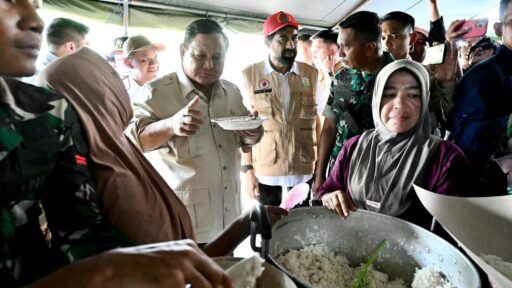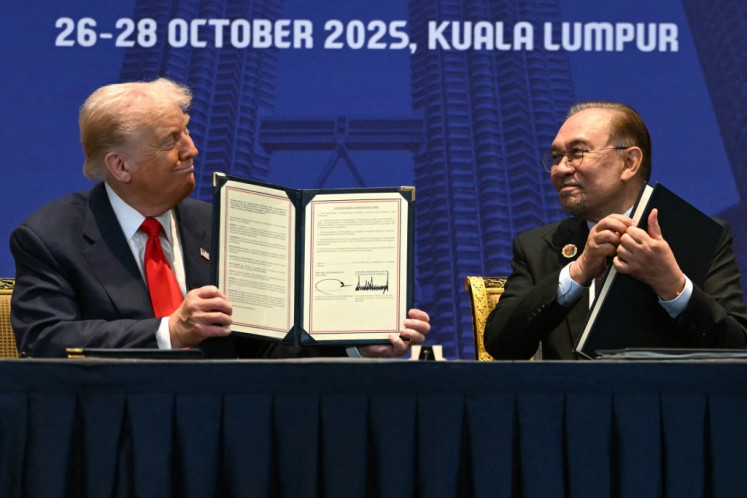Popular Reads
Top Results
Can't find what you're looking for?
View all search resultsPopular Reads
Top Results
Can't find what you're looking for?
View all search resultsQuestioning BI decision to cut interest rate
On Feb
Change text size
Gift Premium Articles
to Anyone
O
n Feb. 17 Bank Indonesia (BI) decided to lower its BI rate by 25 basis points (bps) from 7.75 percent to 7.5 percent and cut the Deposit Facility rate by 25 bps to 5.5 percent but maintained the Lending Facility rate at 8 percent. Some analysts said that the lower BI rate was a deliberate strategy to weaken the rupiah to boost exports. Was this policy the right decision?
In general, I agree with the policy with two major reservations. First, Indonesia faced deflation in the past two months. The Consumer Price Index (CPI) experienced deflation month-on-month (mom) at -0.24 percent in January and -0.36 percent in February 2015.
This deflation was mainly due to lower administered prices (e.g. fuel prices) and volatile food prices (e.g. chili prices), despite rises in the price of rice. The inflation rate in Indonesia is heavily influenced by those two factors, rather than core inflation factors (e.g. imported inflation).
As a response to the massive drop in the global oil price, the Indonesian government decided to lower subsidized fuel prices on Jan. 19 from Rp 8,500 (65 US cents) per liter to Rp 7,600 a liter reducing inflationary pressure.
On the other hand, the decrease in volatile food prices was mainly because of the drop in chili, chicken and egg prices exceeding the impact of the spike in rice prices.
Second, the trade balance recorded a surplus of about $700 million in January and February 2015, supported by a smaller oil and gas deficit ($30 million) in January, while in February the oil and gas trade was in surplus ($170 million) due to lower world oil prices, even though the volume of oil imports increased.
The government should anticipate this growing oil consumption because, if global oil prices increase, Indonesia's oil and gas trade balance will be in deficit again just as in the last couple of years.
Actually, the increase in fuel prices in November 2014 temporarily reduced fuel consumption implying a decrease in oil imports and a deficit in the trade balance in the next few months.
For instance, one week after the spike in fuel prices in November 2014, subsidized gasoline consumption dropped significantly from 87,000 kiloliters per day to 72,000 kl per day.
However, in January 2015 President Joko 'Jokowi' Widodo decided to drop the fuel price again. As a consequence, fuel consumption and oil-import volume increased gradually.
Before the decrease in the fuel price in January, the average consumption of subsidized fuel was always less than 80,000 kl per day. In contrast, fuel consumption is currently about 83,000 kl per day.
Therefore, BI predicts that the current account will still be negative in the first quarter of 2015, although this deficit in the current account will be lower than in the previous quarter.
However, the reduction in interest rates in February had a negative effect. This policy led to a greater depreciation of the rupiah against the dollar. The rupiah has fallen since that policy, reaching more than Rp 13,000 per dollar in early March 2015, the lowest level since the Asian Crisis in 1998.
BI should stabilize the rupiah (at least) to a level of Rp 12,500, the average rate assumed for the 2015 fiscal year, otherwise it will harmfully distort the economy, such as in higher non-performing loans, foreign debt defaults and more expensive raw materials.
In particular, the manufacturing sector and private foreign debt are two sectors that would be enormously affected by the rupiah's depreciation.
About 60 to 70 percent of the basic and intermediate materials used by Indonesia's manufacturing sector are imported products and around 30 percent of private foreign debt is short-term debt, which is highly sensitive to currency volatility.
Furthermore, there was a quite major issue about BI independence when BI lowered the policy rate in February.
Some newspapers indicated that the government intervened in this policy by asking BI to reduce the policy rate to bolster bank lending and economic growth.
The Jokowi administration plans to build a great deal of new infrastructure, such as new ports, airports, social housing, etc., and these massive projects require huge amounts of cheap money.
If the policy rate is lower, the government will have cheaper sources of financing for these projects.
Therefore, BI is currently facing a dilemma: on one side, BI has to stabilize the rupiah and the economy by increasing the policy rate (tight monetary policy) but at the same time BI is facing political pressure for an easier monetary policy to support fiscal expansion.
If there is no good coordination between BI and the government, both fiscal and monetary policies will be less effective.
__________________
The writer is a researcher at the Institute for Development of Economics and Finance (INDEF).










